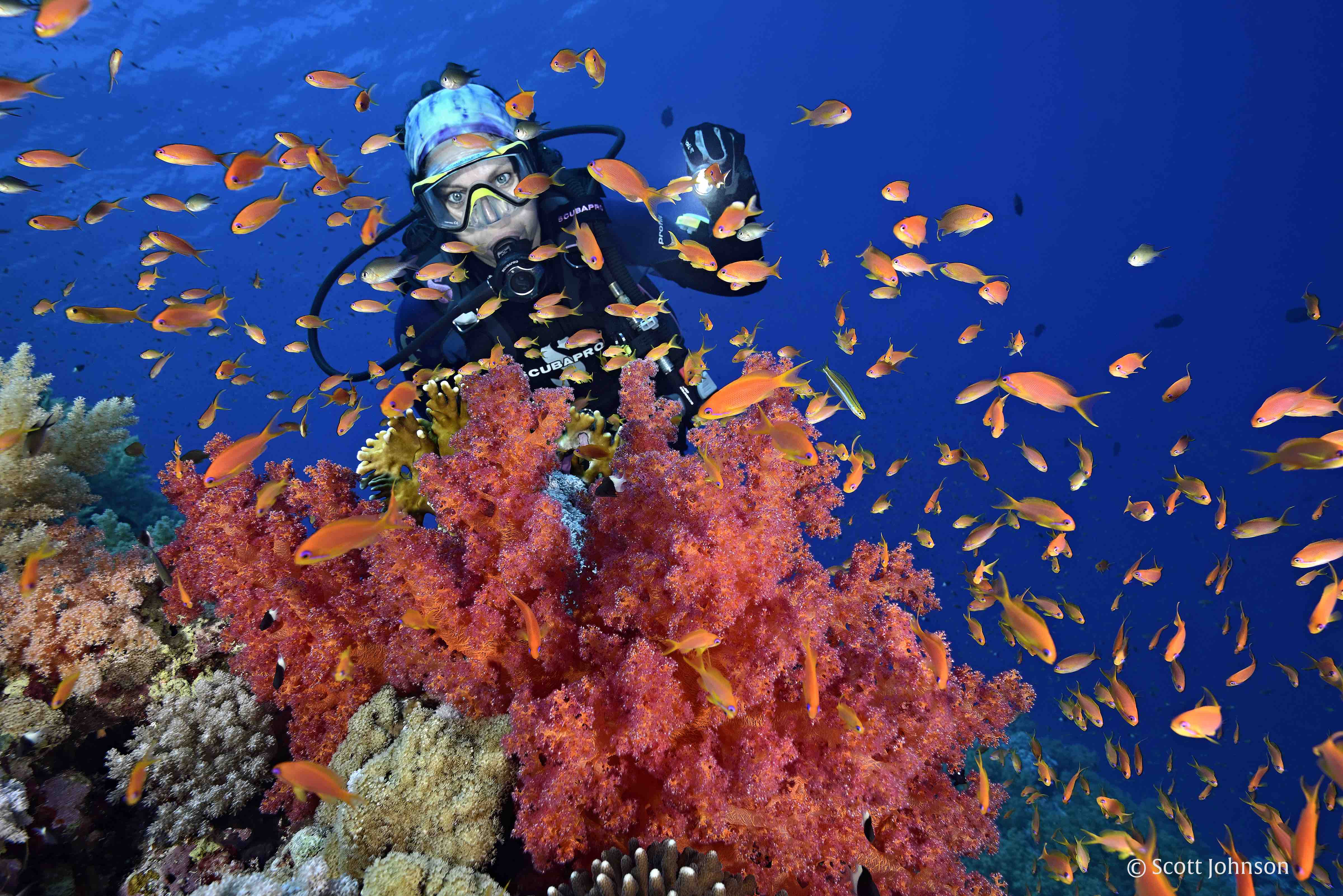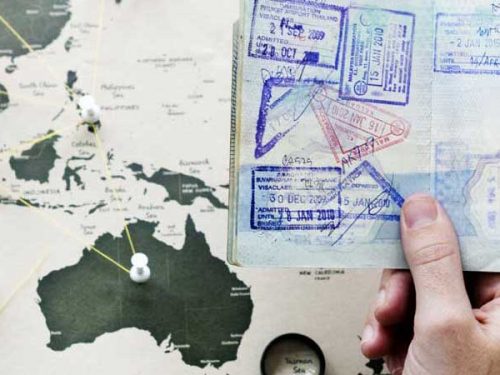One of Earth’s major bodies of water, the Red Sea is a diving wonderland. With hundreds of awesome dive sites, this Middle Eastern destination is fascinating. Famous wrecks lie just beneath the surface, including the SS Thistlegorm, and healthy coral reefs, such as Ras Mohammed Marine Reserve, attract hundreds of fish species. Because of the number of great dive sites dotted around Egyptian territory, the best option for scuba diving the Red Sea is a liveaboard. These eat, sleep, dive boats allow vacationers to explore all the dive sites in a particular region over the course of a week. On a liveaboard, you’ll see a greater variety of dive sites and are able to get to dive sites that cannot be reached by day boats.
The Best Places to Dive in the Red Sea
Whether you choose to dive in the northern, central or southern Egyptian Red Sea, there are plenty of dive sites to explore. From wrecks to reef and walls, here are some of the best diving areas in the Red Sea.
The Thistlegorm
Occasionally referred to as the best wreck dive in the world, the SS Thistlegorm is located in the Northern Red Sea. The wreck is 420 feet long and was a British transport ship in its previous life. In 1941, she was sunk by a German air attack and remains an underwater history museum complete with WWII era jeeps, tanks and other cargo. The SS Thistlegorm can be reached by liveaboard or on a day trip from Sharm El Sheikh.
- Egyptian Red Sea Region: North
- Liveaboard or Day Boat: Both
- Port of Departure: Sharm El Sheikh, Hurghada (liveaboard only)
Ras Mohammed National Park
Known for its diverse marine life and coral reefs, Ras Mohammed National Park is a popular region of the Red Sea for divers. The protected area sits at the junction of the Gulf of Suez and the Gulf of Aqaba.
- Egyptian Red Sea Region: North
- Liveaboard or Day Boat: Both
- Port of Departure: Sharm El Sheikh, Hurghada (liveaboard only)
The Brothers Islands
A popular liveaboard destination in the central section of the Egyptian Red Sea, The Brothers Islands are a pair of tiny islands situated about 5 minutes apart. Surrounded by deep walls and the occasional shallow reef plateau, the shark diving around The Brothers is particularly good. Silvertips and grey reef sharks frequent the area and occasionally divers can see hammerheads swimming up from the deep. You need to be comfortable with currents on these dives.
- Egyptian Red Sea Region: South
- Liveaboard or Day Boat: Liveaboard
- Port of Departure: Marsa Alam (Port Ghalib) , Hurghada (liveaboard only)
Daedalus
Daedalus Reef in the southern Red Sea is accessible only by liveaboard. This vibrant marine ecosystem boasts gorgeous, coral-covered walls. Hammerhead sharks and manta rays are occasionally seen at this pristine dive site.
- Egyptian Red Sea Region: South
- Liveaboard or Day Boat: Liveaboard
- Port of Departure: Marsa Alam (Port Ghalib)
Elphinstone
Famous for spotting oceanic whitetip sharks, Elphinstone is located in the southern Red Sea near Marsa Alam. With walls and plateaus, the island is one of the best dive sites in the area. Gorgonian fans cover the deep walls and trevallies hunt on the plateaus. Discover Elphinstone through liveaboard diving in Egypt’s Red Sea.
- Egyptian Red Sea Region: South
- Liveaboard or Day Boat: Both
- Port of Departure: Marsa Alam (Port Ghalib)
St. John’s Reef
St. John’s Reef is located In the Southern Red Sea, not far from the border with Sudan.The area hosts several reef dives that are esteemed for their soft corals, black corals and pelagic fish species. Interesting swim-throughs make for beautiful exploratory dives. If you’re lucky, you might encounter hammerhead sharks here.
- Egyptian Red Sea Region: South
- Liveaboard or Day Boat: Liveaboard
- Port of Departure: Marsa Alam (Port Ghalib)
The Rosalie Moller
One of Egypt’s many wreck dives, the Rosalie Moller is the sister ship to the Thistlegorm. She, too, was bombed by the Germans in 1941 and lies at 55 meters. The main deck lies at 35 meters and the mast can be seen at 18 meters. More of an advanced to technical dive, this wreck is now covered in coral and makes for great underwater photos.
- Egyptian Red Sea Region: North
- Liveaboard or Day Boat: Both
- Port of Departure: Sharm El Sheikh, Hurghada
Abu Nuhas
At least 7 wrecks have been found around the dive site known as Abu Nuhas. Four of these are suitable for recreational divers, namely the Carnatic, the Chrisoula K, the Giannis D and the Kimon M. Access is possible on a day trip from Hurghada or on liveaboards from Sharm el Sheikh.
- Egyptian Red Sea Region: North
- Liveaboard or Day Boat: Both
- Port of Departure: Sharm El Sheikh, Hurghada
Salem Express
A ferry that sank in 1991, the Salem Express is considered one of the greatest marine tragedies in history. Up to 1000 people died when the boat sank in the middle of the night. If you chose to dive this site, it’s important to remain respectful of the tomb that it became. The site ranges from 12 to 30 meters, and there is little fauna surrounding the wreck.
- Egyptian Red Sea Region: North/Central
- Liveaboard or Day Boat: Both
- Port of Departure: Sharm El Sheikh, Hurghada, Marsa Alam (Port Ghalib)
Fury Shoals
Fury Shoals offers divers the chance to explore pristine reefs in the southwest Red Sea. There are a variety of dive sites available, including historic wrecks, drop-offs and coral reefs. Marine life is also varied from sharks to macro critters hidden on the sea bed.
- Egyptian Red Sea Region: Southwest
- Liveaboard or Day Boat: Liveaboard
- Port of Departure: Marsa Alam (Port Ghalib)
Strait of Gubal
The Strait of Gubal offers tons of shipwrecks to advanced divers as well as pristine coral and lots of marine life. In previous years, the Straits were only accessible by liveaboard from Hurghada and Sharm El Sheikh, but with options from El Gouna north of Hurghada divers can also access these sites on a day trip.
- Egyptian Red Sea Region: Northwest
- Liveaboard or Day Boat: Both
- Port of Departure: Sharm El Sheikh (by liveaboard), Hurghada (by liveaboard), El Gouna (day boat)
Strait of Tiran
Considered the best diving destination near Sharm El Sheikh, the Strait of Tiran is home to four pristine reef system, namely Jackson Reef, Woodhouse Reef, Thomas Reef and Gordon Reef. Deep walls and sightings of pelagic species round out this northern Red Sea paradise.
- Egyptian Red Sea Region: North
- Liveaboard or Day Boat: Both
- Port of Departure: Sharm El Sheikh, Hurghada (liveaboard only)
Dahab
A scuba diving destination in its own right, northern-bound liveaboards often stop in the region to enjoy Egypt’s most famous Blue Hole. The canyon also attracts thrill-seekers, although advanced training is required.
- Egyptian Red Sea Region: Northern
- Liveaboard or Day Boat: Both
- Port of Departure: Sharm El Sheikh, Dahab (shore diving only)
Points of Departure for Diving the Red Sea
In terms of Red Sea diving, liveaboards are the best option, in our opinion. From these three departure points, you’ll be able to reach the best dive sites in the area. Plus, you’ll gain access to busy sites at the best times each day.
Hurghada
Located on the western coast of the Red Sea, Hurghada is an excellent option for those who want to explore both the northern and central sections of the Red Sea. Liveaboards often travel from Hurghada to the best wrecks in the Red Sea (Thistlegorm, Rosalie Moller, Abu Nuhas and more) as well as The Brothers Islands.
Marsa Alam (Port Ghalib)
Also on the west coast of the Red Sea, Marsa Alam (Port Ghalib) is located in the south of Egypt. There are plenty of dive sites reachable from shore, but Marsa Alam is an excellent starting point for a southern Red Sea liveaboard. Routes reach destinations such as The Brothers, Daedalus, Elphinstone, St. Johns Reef and Fury Shoals. Plus, the best shark diving in the Red Sea can be found here.
Sharm El Sheikh
Perhaps the most popular beach destination in all of Egypt, Sharm El Sheikh is located on the southern point of the Sinai Peninsula. An ideal location for exploring the northern section of the Red Sea, Sharm is also a starting point for some liveaboards, and you’ll find plenty of boats plying the waters around Ras Mohamed, the Straits of Tiran, Dunraven, Abu Huhas, the Thistlegorm, the Straits of Gubal, Ras Abu Galum, and occasionally Dahab.








